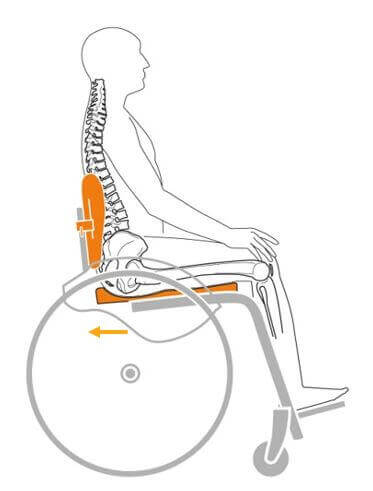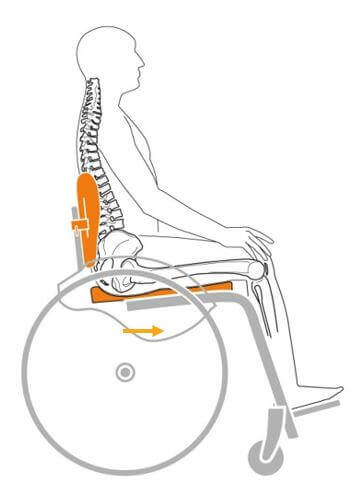When the rear axle is set correctly for a self-propelling manual wheelchair user, the wheelchair feels better and opens up the most independent performance. Set poorly, and the wheelchair can become unstable, painful, and immovable.
One of the first concepts most high-end manual wheelchair prescribers learn is that, generally, moving the rear axle forward makes propulsion easier but reduces the rear stability. This isn't inherently a bad thing, as a little rearward "tippiness" is needed to clear small, everyday obstacles.
An oft quoted guideline for users with moderate- or high-level self-propulsion skills is to set the rear axle center at the tip of the client's middle finger. This meets the needs of most wheelchair users with moderate manual mobility skills and typical center of mass. That is, it works fairly well for people who are somewhere near the proportions of an average crash test dummy. But what to do when this might not be a good starting point?
1. User's center of mass is quite rearward

- Amputees, particularly double amputees
- Petite clients with very little weight held in their abdomen, chest, thighs, and lower limbs
- Clients who hold most of their soft tissue mass in their gluteal area, particularly if combined with one or more of the above
Recommendation: Start with a more conservative setting, but with caution. The farther back a rear axle setting goes, the more hyperextension of shoulder is needed to propel, which can make propelling inefficient and increase the risk of upper limb trauma such as repetitive strain injury. Trying in line with backcanes is a good place to start, and ensure you order a very configurable wheelchair. Even with a relatively rear-set personal center of mass, some clients can tolerate a more active position. For amputees who have the ability to develop wheelchair mobility skills, I would recommend starting here and considering 2x anti-tips and additional training.
2. User's center of mass is quite forward

- Clients with large amounts of weight held in lower limbs, such as clients with chronic edema
- Clients with very little rear gluteal mass, particularly in combination with large chest, abdominal, or lower limb soft tissue areas
Recommendation: Larger clients are particularly likely to have forward centers of gravity, and therefore load the front caster wheels heavily if they do not have a forward-set center of gravity. Unfortunately, heavy-duty wheelchairs sometimes have even less ability to bring the center of gravity setting forward! Suggest going brave, with axle position an "active" position of approximately 5 cm in front of the backcanes, even on moderate or low active users, again with anti-tippers if initially needed until confidence is built up. This is even more important if a caregiver assists and has to tip the front caster wheels up over thresholds to push the chair.
Faith Brown, Occupational Therapist (OT), Clinical Specialist - Sunrise Medical UK & Éire, is an HCPC registered Occupational Therapist with a postgraduate certificate in Postural Management for People with Complex Disabilities from Oxford Brookes University. She is a member of PMG (Posture and Mobility Group).